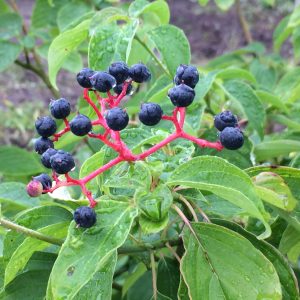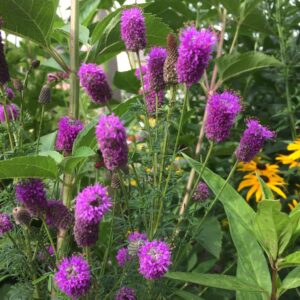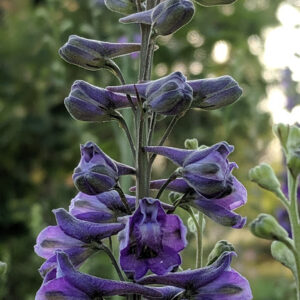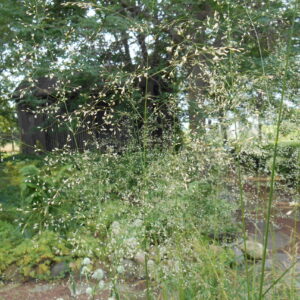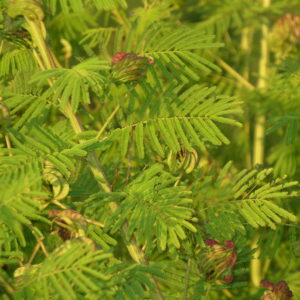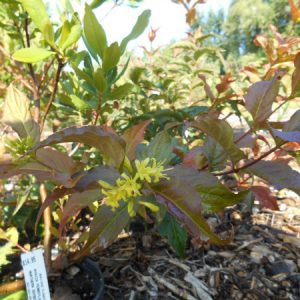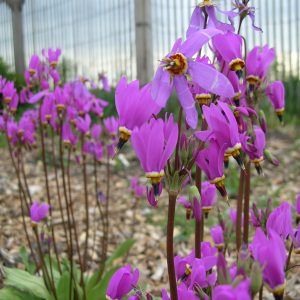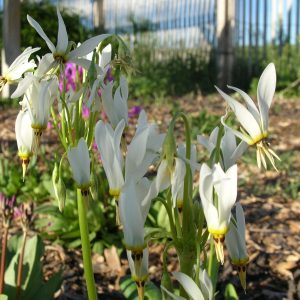Prairie Plants
Showing 25–32 of 81 results
-
Cornus alternifolia Pagoda dogwood Z 4-7
Small tree with horizontal branches in flat tiers & a flat top, like the roof of a pagoda, bearing fragrant white flowers in early summer & blue berries on red stems against maroon leaves in fall.
Small tree with horizontal branches in flat tiers & a flat top, like the roof of a pagoda, bearing fragrant white flowers in early summer & blue berries on red stems against maroon leaves in fall.
Size: 15-30’ x 15-30’
Care: part shade in moist to moist well-drained soil – great understory tree.
Native: Canada to GA, west to MN – WI native
Wildlife Value: Hosts Spring azure butterfly caterpillar. Both food and shelter for Bluejay, Catbird, Chickadee, Flicker, Grosbeak, Junko, Oriole, Sparrow, Tanager, Thrush, Woodpecker, and food for more than 20 additional birds who eat the fruits.
Awards: Great Plants for Great PlainsAlternifolia means leaves alternating on stem. Cherokee chewed bark for headaches, sore throat, worms, measles & diarrhea. Poltice topically applied on ulcers & a decoction for colds & cough. Collected and described in writing before 1753. Grown at America’s 1st botanic garden, Elgin Botanic Garden 1811.
**LISTED AS OUT OF STOCK BECAUSE WE DO NOT SHIP THIS ITEM. IT IS AVAILABLE FOR PURCHASE AT OUR RETAIL LOCATION.
-
Dalea purpurea syn. Petalostemon purpurea Violet prairie clover Z 4-9
Vase shaped clump with wands of violet to purple encircling tall coneheads mid-summer
Vase shaped clump with wands of violet to purple encircling tall coneheads mid-summer
Size: 2’ x 18”
Care: full sun in well-drained to moist well-drained soil.
Native: Canada to Texas, Wisconsin native
Wildlife Value: Host for caterpillars of Dogface Sulphur, Striped blue & Mexican blue butterflies. Supports over 80 bee species including endangered Rusty patched Bumble BeesDalea named to honor English botanist Dr. Samuel Dale (1659- 1739.) Chippewa, Meskwaki and Navajo used medicinally – as remedies for heart ailments, pneumonia, diarrhea and measles. Comanche and Lakota chewed the root like gum, for its sweet taste. Sioux combined it with Amorpha canescens, Leadplant to ambush bison. Sioux also treated fevers and stomach disorders with an infusion made from the plant. Pawnee made brooms from the flexible stems. 1st collected by French botanist André Michaux (1746-1802) who spent 11 years in America collecting hundreds of new plants.
-
Delphinium exaltatum Tall Larkspur, American larkspur Z 4-8
Graceful, lavender or purple spikes of trumpets on tall stems in July to August.
Graceful, lavender or purple spikes of trumpets on tall stems in July to August.
Size: 3-4' x 9"
Care: Care: sun to part shade in moist well-drained soil. Withstands winds, no staking needed. Not fussy like fancy hybrids. Tougher and much longer living than modern hybrids. Let the seeds drop & you’ll get some babies.
Native: Pennsylvania to No. Carolina west to Ohio & Alabama
Wildlife Value: attract hummingbirdsDelphinium, named by Dioscorides, is Greek for “dolphin” due to the resemblance of the flower shape. According to Aiton, early director at Kew Royal Garden, John Bartram (1699-1777) sent it to England. London’s Chelsea Physic gardener Philip Miller grew it in 1758. Jefferson planted this at Monticello in the NW quarter of the outer border in March 1811.
-
Deschampsia caespitosa Hair grass Z 4-9
Airy pink panicles, like delicate billowing clouds of seed heads, top clumps of arching slender leaves in mid- summer persisting through winter.
Airy pink panicles like delicate billowing clouds of seed heads, top clumps of arching slender leaves in mid-summer persisting through winter.
Size: 2-4' x 18"
Care: moist soil in sun to shade
Native: Europe, Asia & No. America, Wisconsin nativeDeschampsia named for French botanist Deslongchamps (1774-1849.) Caespitosa means that it grows in clumps. This species found by mid-1700’s.
-
Desmanthus illinoensis Prairie mimosa, Illinois bundleflower Z 5-9
This legume bears round heads of frilly white flowers that turn to interesting spherical seed pods persisting all winter.
This legume bears round heads of frilly white flowers that turn to interesting spherical seed pods persisting all winter.
Size: 4’ x 3’
Care: sun in moist well-drained to dry soil. Looks like a shrub but is a perennial.
Native: Ohio to Florida and west to New Mexico and all states in between
Wildlife Value: Seeds are food for birds including the Ring-Necked Pheasant, Bobwhite Quail, and Greater Prairie Chicken.Desmanthus is Greek meaning “bundle flower” because the bunched flowers look like a bundle. Pawnee, Sioux, Omaha & Ponca children used seed pods with dried seeds as rattles. Pawnees relieved itching with the boiled leaves. Sioux ate roasted seeds. First collected by French plant hunter Michaux in the late 1700’s.
-
Diervilla lonicera Northern bush honeysuckle Z 3-7
Lemon yellow flowers on this short shrub June to August. In fall its foliage turns dark red for the final fireworks’ display. Great shrub for tough, dry shady areas.
Lemon yellow flowers on this short shrub June to August. In fall its foliage turns dark red for the final fireworks’ display.
Size: 3’ x 3’ spreading
Care: sun to part shade in well-drained soil, drought tolerant
Native: Eastern half of US & Canada, Wisconsin native.
Wildlife Value: nectar source for Bumblebees. Birds make nests from the branches and eat the fruitsUsed medicinally by numerous Native Americans – Algonquin, Chippewa, Cree, Iroquois, Menominee, Meskwaki, Ojibwa and Potawatomi. Used as remedy for sore eyes, diuretic, “old men who cannot retain urine,” constipation, stomach pain, increase breast milk, to “spoiled babies with adulterous mother,” STD’s and vertigo. Dr. N. Dierville, a surgeon, carried this to France from Canada (then Acadia) in 1699. Botanist to France’s king, Louis XIV, Joseph Pitton de Tournefort (1656-1708) named this to honor Dierville
**LISTED AS OUT OF STOCK BECAUSE WE DO NOT SHIP THIS ITEM. IT IS AVAILABLE FOR PURCHASE AT OUR RETAIL LOCATION.
-
Dodecatheon meadia syn. Primula meadia Pink Shooting Star Z 4-8 Ephemeral
Rosy-lilac reflexed flowers, looking like a descending shuttlecock, dangle from stems in spring
Only available for purchase in spring – Ephemeral
Rosy-lilac reflexed flowers, looking like a descending shuttlecock, dangle from stems in spring
LIMITED QUANTITIES AVAILABLE. LIMIT OF 1 PER CUSTOMER PLEASE.
Size: 12-24” x 6-12”
Care: sun to part shade in moist well-drained soil.
Native: PA to Wisconsin, south to TX.
Awards: Royal Horticultural Society Award of MeritName Dodecatheon from the Greek dodeka (twelve) and theos (gods), meaning 12 superior gods, after the name given to another plant by Roman author, Pliny the Elder. The species name meadia after Richard Mead, physician to George III. John Tradescant the Younger sent this to England by 1640. “A favorite among old border flowers.” William Robinson, 1899.
-
Dodecatheon meadia syn. Primula meadia Shooting Star Z 4-8 Ephemeral
White reflexed flowers, looking like a descending shuttlecock, dangle from stems in spring. Ephemeral. Let it drop its seed and in three years you will have more. There are pink ones but not as vigorous, rare.
Available to order in Spring only
White reflexed flowers, looking like a descending shuttlecock, dangle from stems in spring. Ephemeral. Let it drop its seed and in three years you will have more. There are pink ones but not as vigorous, rare.
Size: 12” x 6”
Care: sun to part shade in moist well-drained soil
Native: PA to Wisconsin, south to TX.
Awards: Royal Horticultural Society Award of Merit.Dodecatheon from the Greek dodeka (twelve) and theos (gods), meaning 12 superior gods, after the name given to another plant by Roman author, Pliny the Elder. The species name meadia after Richard Mead, physician to English King George III. John Tradescant the Younger sent this to England by 1640. “A favorite among old border flowers.” William Robinson, 1899. This showy native can be found in open woodland, prairies, meadows, and on rocky slopes in the eastern United States. Introduced into European gardens as early as 1704, Philadelphia nurseryman and explorer John Bartram described this species of Dodecatheon in 1783. The white version was offered, along with several in shades of purple, by Long Island’s Prince Nursery in 1857.

